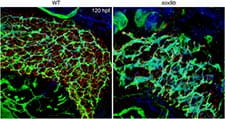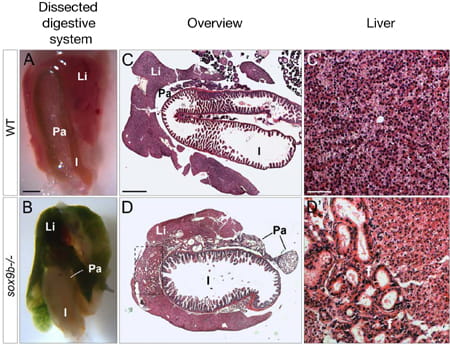Hepatic Biliary Cells
Hepatic biliary cells, which line the bile ducts, are targets of liver injury, but also orchestrate liver repair. During development, both hepatocytes and hepatic biliary cells derive from bipotential hepatoblasts. Hepatic biliary cells undergo extensive morphogenesis to form a complex network of intrahepatic biliary ducts. This network functions to drain the bile produced by hepatocytes to the intestine. Defects in the formation and morphogenesis of intrahepatic biliary network are responsible for many human congenital liver diseases. However, our understanding of the molecular mechanisms regulating the development of this network remains very limited.
In zebrafish, hepatic biliary cells are responsive to Notch signaling and thus can be easily visualized in a Notch reporter line Tg(Tp1bglob:GFP). Using this tool, we characterized the sox9b mutants that fail to assemble a functional intrahepatic biliary network. As a result, the adult mutants exhibit cholestasis associated with hepatic cyst formation and fibrosis. We continue analyzing the molecular and cellular mechanisms underlying the biliary defects in sox9b mutants.
Using the Notch reporter line, we conducted a forward genetic screen and identified other mutants that are defective in hepatic biliary cell differentiation or morphogenesis. Studying these mutants will help us better understand the cell biology of hepatic biliary cells. Our work in zebrafish will also bring novel insights into our understanding of human biliary diseases, which may translate into novel therapies.





